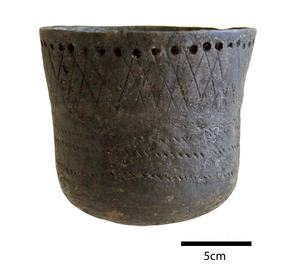It looks like you're using an Ad Blocker.
Please white-list or disable AboveTopSecret.com in your ad-blocking tool.
Thank you.
Some features of ATS will be disabled while you continue to use an ad-blocker.
3
share:
In a new paper a research group has found the oldest use of pottery, from a shell midden in Japan.
Dated to the incipient Jomon period the Torihama shell mound has an extensive occupation history
Researchers used shards from a pot like this to determine that the Jomon cooked fish

Here's an abstract of the study
www.nature.com...
And John Hawks' rather critical commentary of a commentary of the article.
johnhawks.net...
I have my own comments but am busy making tomato machine parts right now so later
Dated to the incipient Jomon period the Torihama shell mound has an extensive occupation history
Torihama is the name of a water-logged freshwater mollusc shell midden, located on the Hasu River near Wakasa Bay in Fukui Prefecture, Japan. Torihama was used as a midden and sometime residence throughout the Jomon period in Japan, with the largest deposits laid down during the Early Jomon period. The mound measures at least 120 meters (about 400 feet) across, with deposits up to 2 m (6 ft) in depth.
Researchers used shards from a pot like this to determine that the Jomon cooked fish

Here's an abstract of the study
Pottery was a hunter-gatherer innovation that first emerged in East Asia between 20,000 and 12,000 calibrated years before present 1, 2 (cal BP), towards the end of the Late Pleistocene epoch, a period of time when humans were adjusting to changing climates and new environments. Ceramic container technologies were one of a range of late glacial adaptations that were pivotal to structuring subsequent cultural trajectories in different regions of the world, but the reasons for their emergence and widespread uptake are poorly understood. The first ceramic containers must have provided prehistoric hunter-gatherers with attractive new strategies for processing and consuming foodstuffs, but virtually nothing is known of how early pots were used. Here we report the chemical analysis of food residues associated with Late Pleistocene pottery, focusing on one of the best-studied prehistoric ceramic sequences in the world, the Japanese Jōmon. We demonstrate that lipids can be recovered reliably from charred surface deposits adhering to pottery dating from about 15,000 to 11,800 cal BP (the Incipient Jōmon period), the oldest pottery so far investigated, and that in most cases these organic compounds are unequivocally derived from processing freshwater and marine organisms. Stable isotope data support the lipid evidence and suggest that most of the 101 charred deposits analysed, from across the major islands of Japan, were derived from high-trophic-level aquatic food. Productive aquatic ecotones were heavily exploited by late glacial foragers 3 , perhaps providing an initial impetus for investment in ceramic container technology, and paving the way for further intensification of pottery use by hunter-gatherers in the early Holocene epoch. Now that we have shown that it is possible to analyse organic residues from some of the world’s earliest ceramic vessels, the subsequent development of this critical technology can be clarified through further widespread testing of hunter-gatherer pottery from later periods
www.nature.com...
And John Hawks' rather critical commentary of a commentary of the article.
Fishing for white elephants F r i , 2 0 1 3 - 0 4 - 1 9 1 5 : 2 4 - - J o h n H a w k s
Barbara King notes the recent characterization of fish cooking residues on early Japanese pottery: "What 15,000 Years Of Cooking Fish Tells Us About Humanity". She focuses on the relationship between status-seeking and innovation:
The idea is that hunter-gatherers — who, during many periods and in many habitats, enjoyed enoughabundance not to eat hand-to-mouth to survive — accorded special status to some foods. In discussing this possibility, Oliver Craig sent me an article published 10 years ago in thejournalWorld Archaeology by Brian Hayden that establishes a good frame of reference. Hayden describes some Southeast Asian prehistoric societies, among the first to domesticate plantsand animals,thathethinks also produced the first "luxury goods" — foods used in the context of ceremonial feasting.
Status imposes demands over and above survival, spurring innovation beyond what might be expected from mere subsistence requirements. Unlike survival, status-seeking selects for white elephants: costly and non-portable technologies.
johnhawks.net...
I have my own comments but am busy making tomato machine parts right now so later
new topics
-
University of Texas Instantly Shuts Down Anti Israel Protests
Education and Media: 44 minutes ago -
Any one suspicious of fever promotions events, major investor Goldman Sachs card only.
The Gray Area: 2 hours ago -
God's Righteousness is Greater than Our Wrath
Religion, Faith, And Theology: 7 hours ago -
Electrical tricks for saving money
Education and Media: 10 hours ago -
VP's Secret Service agent brawls with other agents at Andrews
Mainstream News: 11 hours ago
3
